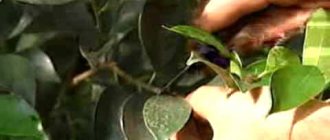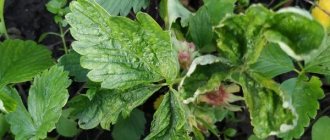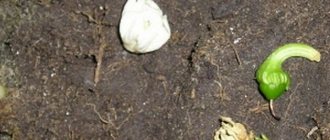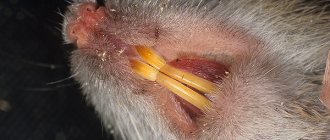Vegetable growing » Cabbage
0
4961
Article rating
Kira Stoletova
Cabbage is not picky about care. But there are cases when cabbage has purple leaves, and there may be several reasons for this.
Causes of purple cabbage leaves
How to stop the pulling of seedlings
If cabbage seedlings stretch upward, then it is necessary to take urgent measures to save the planting material. First of all, you should find out the main reason and adjust the care and maintenance of seedlings. You can act in such a situation in different ways, so each gardener decides for himself which method is more acceptable for him.
Cold therapy
You can stop the stretching of cabbage seedlings by sharply reducing the temperature. A balcony or loggia can help with this. First, containers with seedlings should be kept at a temperature of +4 degrees for 5 days. After this, the mode can be increased to +10-+12 degrees. Such conditions should be maintained for 10 days.
In the future, cabbage seedlings should be kept at a temperature of +14-+16 degrees for 1.5 weeks. And after that, move on to the optimal maintenance regime. It provides for mandatory temperature changes, depending on the time of day. During the day within +15-+18 degrees, and at night – no more than +8-+10 degrees. This regime guarantees moderate growth of the aboveground part and full development of the root system.
Forming a loop
This method is recommended if the cabbage is too stretched. To restore the seedlings, it is necessary to replant by wrapping the stem around the diameter of the container in the form of a loop, and then sprinkle it with earth. 3 days before this, it is necessary to stop watering the seedlings and reduce the temperature by 5-7 degrees. This will minimize stress on the plant and make the stem more pliable and flexible.
At the end of the procedure, the soil surface must be compacted. And then keep the substrate constantly slightly moist.
Treatment with growth stimulants
You can prevent further stretching of cabbage using special chemicals. They contain components that suppress the synthesis of hormones - gibberellins, which are responsible for the growth of the aerial part. These preparations are designed specifically for young seedlings and help redirect the plant’s forces to the development of the root system. Also, thanks to their action, the main stem of the seedlings thickens, the distance between the leaves decreases and the size of the plates increases.
The most effective growth stimulants:
- "Athlete";
- "Amulet";
- "Stopprost."
The drugs must be used according to the attached instructions, strictly observing the indicated dosages. The working solution should be watered at the roots of the plants or sprayed on the leaves.
Note! Regulators can be used for elongated seedlings no more than 3 times, and you must stop using them 5 days before transplanting the plants into open ground
Adding substrate to containers with seedlings
The situation can be corrected by adding soil up to the first pair of leaves, if there is enough space in the planting container. This technique will allow you to slow down the growth of the above-ground part and redirect the plant’s forces to the development of the root system.
If necessary, the procedure can be repeated after a few weeks.
Picking
This method is considered the most effective. It is recommended to pick when the first true leaves appear. To do this, you will need to prepare special soil and seedling cassettes.
Fill each cell with nutrient substrate, moisten it and make a depression in the center. Then remove the seedling from the general container, shorten the main root by 1/3 of the length and bury it in the soil until the first leaves. After this, sprinkle it with soil, compact the surface and water again.
This method helps slow down the growth of the above-ground part due to the stress that the seedlings experience during transplantation and the growth of additional roots.
Why does white cabbage have purple leaves, ways to solve the problem
You don't always need to panic if your cabbage leaves turn purple. Most often the problem is fixable. So, if the leaves of a seedling turn blue shortly after planting it in the garden, this is most likely a stressful situation and everything will go away over time. But if the color change happened later, the reason may be deeper.
Nutrient deficiencies
Nitrogen and phosphorus affect the color of cabbage leaves the most. Cabbage takes up a huge amount of water and nutrients from the soil, so it must be planted in well-fertilized soil. If a gardener suspects that he is to blame for underfeeding his pets, he needs to feed the cabbage using complex fertilizers.
Possible contraindications
Best materials of the month
- Coronaviruses: SARS-CoV-2 (COVID-19)
- Antibiotics for the prevention and treatment of COVID-19: how effective are they?
- The most common "office" diseases
- Does vodka kill coronavirus?
- How to stay alive on our roads?
Some people may experience flatulence and indigestion when consuming cabbage. But if dysfunction in the stomach is caused by white cabbage, this does not mean that the same result will be from red cabbage or broccoli. By the way, Indian Ayurveda, to facilitate the digestion of cabbage, recommends cooking it with garlic, onion or ginger in olive oil, rich in vitamin E and fatty acids. But the combination of several varieties of cabbage in one dish can increase the unpleasant effect in the form of indigestion or flatulence. Also, raw cabbage is contraindicated for duodenal ulcers.
It is also important to know that red cabbage is on the list of goitrogenic foods, the consumption of which inhibits the body’s absorption of iodine. And this is fraught with the development of iodine deficiency.
Like other cruciferous vegetables, red cabbage has the ability to absorb purines from the soil, which, when entering the human body, are converted into uric acid. Excessive consumption of vegetables can be dangerous for people with kidney disease, since their bodies are not able to fully remove excess uric acid. And this is a direct path to the development of gout.
What causes cabbage leaves to turn purple?
There are several reasons why cabbage may begin to change its color:
- Phosphorus and nitrogen are essential components for the healthy growth of this vegetable. The main reason for the development of the problem may be an acute shortage of these nutrients.
- Improper care of the plant or violation of the conditions for growing cabbage. For example, low or high humidity levels, transplanting at the wrong time, as well as low air temperatures. These factors have a detrimental effect on the stress level of the vegetable.
- Damage to the root system, due to which fungal infections develop. They can completely destroy such a crop due to the cessation of the supply of nutrients to the plant.
If the leaves of the plant begin to change their natural color, then it is necessary to apply phosphorus fertilizers. Otherwise, the growth of the vegetable will stop abruptly, and the top of the stem will not set.
What to do if a purple tint appears on the leaves
The method for eliminating purple leaf color depends on the cause. There is no single method for restoring normal leaf color. Measures must be taken immediately while there is a chance to save the harvest.
Combating micronutrient deficiencies
If the cabbage beds have acquired a purple tint due to vitamin starvation, fertilizing will solve this problem. You can use superphosphate as a fertilizer or use traditional methods. Phosphorus activates the growth of seedlings, improves the condition of adult heads of cabbage, and improves the metabolic system.
Depending on the degree of phosphorus deficiency, you can feed with regular or double superphosphate. The second is characterized by a higher degree of phosphorus concentration. To prepare a liquid solution you will need superphosphate (100 g) and water (10 l). Fertilizer must be applied to each seedling in a volume of up to 0.5 liters. If you purchased a double composition fertilizer, dilute it in different proportions.
Many summer residents avoid the use of chemical fertilizers and prefer traditional recipes. For example, you can make your own organic-based fertilizer. Bird droppings or manure are perfect for this. 3 to 5 kg of rotted organic matter per 1 m2 of cabbage bed is enough.
Another way to saturate the soil with phosphorus is a solution based on bone meal. One teaspoon of flour is enough for 1 liter of water. Let the solution sit until the flour is completely dissolved. Such measures will fully provide your crop with phosphorus and help eliminate the unusual color of the leaf blades.
Saving cabbage from “stress”
Initially, analyze what changes in plant care could cause the purple color on the leaves. Was there a sudden cold snap? How often do you water? How much watering?
It’s not difficult to save cabbage from hypothermia. To insulate the bed, you will need a special covering material - spunbond. Cover the seedlings, and the crop will survive even frost without complications. The covering film protects plants during unfavorable weather - hail, snow and strong winds. If it is not possible to purchase such material, then use mulching.
Waterlogging can occur not only due to excessive watering, but also due to prolonged rains. During such periods, stop watering, but increase the frequency of loosening. Make special narrow furrows to drain excess water.
In case of hot weather, dry soil occurs. Increase the frequency and volume of watering. Remember that cabbage is a moisture-loving plant, but there is no need to pour more than 3 liters per head of cabbage.
Getting rid of the “black leg”
The fungal disease “blackleg” is dangerous for cabbage at any stage of the growing season - from seedlings to an adult head of cabbage. The “black leg” is determined by the root collar with black grooves. Fungal spores spread well in high humidity and acidic soil.
If you notice the disease at the initial stage, a special solution will save the plant. Take 1 gram of potassium permanganate 1% and dissolve in 150 grams of water. The resulting mixture should sit for at least 5 hours. For one head of cabbage you will need a liter of water. Pour the solution under the root. If the disease spreads to the stem and further, spray the entire head of cabbage.
In case of more severe damage to the plant, treat with fungicides.
Another way to treat plants for “blackleg” is a solution of colloidal sulfur. 10 grams of sulfur per bucket of water will be enough. This volume is enough for 8 heads of cabbage.
If after two weeks there is no improvement, you need to dig up and burn all the diseased cabbage. Treat the top layer of soil with soda solution (2 tsp per liter of water).
Eliminating the effects of stress
Cabbage, like any plant, is subject to stress when conditions change. First, you should analyze the changes that appeared while caring for the plant: maybe the appearance of a purple color or blue color on the foliage is caused by a sharp cold snap or frequent watering of the plant? You can protect cabbage from cold: snow, hail by covering it with spunbond insulating material. If there is no covering material, then the soil should be mulched with peat or sawdust.
Overmoistening the soil can also cause cabbage leaves to turn blue. Prolonged rainfall during the summer growing season can contribute to stress. On such days there is no need to water; soil loosening should be increased. You can make narrow furrows to drain excess water.
Why do bumps appear from injections on the buttocks?
Several factors can lead to the formation of swelling after injections.
- Injection technique.
Have you heard that after injections, nurses with a “light” hand do not get “bumps”? There is a deal of truth in it. “Incorrect intramuscular injection site, administering the drug too quickly, or getting the needle into a nerve or vessel can cause injection bumps,” says the specialist. “Also, compactions can appear as a reaction to the simultaneous administration of a large volume of the drug, frequent injections into the same place,” adds Bulat Yunusov, surgeon at GMS Clinic. - Allergic reaction.
“It can develop due to an overreaction of the immune response to the drug,” the doctor adds. Or - a mixture of drugs. - “Many patients, when injecting themselves, commit the sin of mixing several different drugs in one syringe, which is strictly prohibited. This can cause irreversible complications and serious allergic reactions,” says the doctor.
- Consistency of the drug.
“Oil solutions most often cause swelling and swelling,” says Bulat Yunusov. — These are the drugs that can only be administered intramuscularly. Such injections are characterized by a longer resorption time, and, consequently, an increased risk of complications.” - Incorrectly selected needle.
“A needle that is too long or too short leads to the fact that the medicine enters either very deep muscle layers or into the subcutaneous fatty tissue, that is, it does not reach the muscle layer,” the doctor notes. - Excessive muscle tension during injection.
Intramuscular injections must be performed with a relaxed muscle and preferably in a prone position. - Patient's body weight.
“Build and weight are also factors that need to be taken into account when administering injections,” adds Bulat Yunusov. — Obese patients have a lot of subcutaneous fat. If a drug gets into it, it will inevitably lead to the formation of inflammatory changes (infiltrates, abscesses).”
To prevent injection bumps from appearing, experts advise doing injections following certain rules
“It is important to use needles of the appropriate length and diameter; the choice depends on the patient’s age, injection site, volume of fluid, amount of muscle and fat tissue and solution viscosity,” says Bulat Yunusov. — It is necessary to strictly observe the rules of asepsis and antiseptics
It is preferable to perform injections while lying on a couch or bed.”
Use in cosmetology
Red cabbage juice is a great beauty product. You can’t make a face mask out of it, especially if you still have to leave the house that day. But even drinking juice as a drink can have a positive effect on the condition of the skin of the face and body. A drink rich in nutrients will help improve skin color, make it soft and tender. But in addition to the skin, teeth and nails will also benefit from the juice. And dark-haired people can rinse their hair with cabbage juice, slightly diluted with water. From such procedures the hair will be soft and shiny.
Why don't seedlings grow?
What to do if the seedlings grow slowly or do not grow at all (stand still)? There are several reasons for this:
Poor quality soil
The cause of growth problems may be poor-quality soil prepared from beds in which plants of the same family grew. For example, soil for peppers or eggplants was collected from a tomato bed. The same pathogens have accumulated and basic nutrients have been consumed. In addition, ordinary garden soil quickly depletes and turns sour.
| Advice. Application of complex fertilizers in accordance with the recommended rates and those indicated on the packages can help. When preparing the soil before sowing, add sand, non-acidic peat, humus |
Unsuitable container
The root system of plants requires special favorable conditions. A container that is too narrow or wide, shallow or deep can cause oppression. There are plants that prefer cramped pots, and there are also those who like to sit spaciously. The necessary requirements should be established in advance.
| On a note. There are recommendations where to obtain high-quality 60-day tomatoes there must be a pot with a diameter of at least 15 cm. But this is ideal, I think. There are plastic tomato cassettes 50x50 cm with a capacity of 64 pieces or cabbage cassettes - the same size. They allow you to grow 144 plants at a time. |
We use them. Vegetable growers have this rule: the longer the seedlings grow, the larger the pot should be.
Photo: Cucumbers are grown without picking.
Temperature too low
Low temperature in the window sill area can also be the reason why seedling growth has stopped. Keep in mind that it decreases as you approach the glass. And the surface of the window sill may not be warm enough. It is better to place the container on a stand higher from the surface, creating a small gap.
Improper watering
Many moisture-loving crops, especially cucumbers with their shallow root systems, begin to suffer due to dry soil. This applies to tomatoes, eggplants and peppers. The correct mode of moisture supply should be established. Moisten small seedlings with a spray bottle. As the plants grow, you can use cups or watering cans with a long spout. Use water at room temperature, rain or melt water.
Lack of nutrition
Regardless of the crop, plants need nutrition. This is especially true for small containers, cassettes, for example. To prevent root burns, water the plants first. Then fertilize with any fertilizers in low concentration, taking into account the recommendations presented on the package. Two feedings with a difference of 10–14 days are enough. Be sure to combine fertilizing with watering. A liter of aqueous solution of complex fertilizers is enough per square meter of seedling box.
Photo: Tomatoes are ready for planting.
The deficiency of a specific element will be indicated by the seedling plant.
| Element | Signs of an element shortage |
| Nitrogen | The plant is stunted, with a thin stem and small leaves of pale green color. The lower leaves turn yellow and die. With an excess of this macronutrient, plants become fattened. |
| Phosphorus | The leaves (usually on the underside) acquire a reddish-purple hue. On the lower leaves, discoloration between the veins is observed - chlorosis. |
| Potassium | It is necessary to add potassium when the leaves (ends and edges of the lower leaves) turn yellow. In tomatoes, a clear sign of potassium starvation is that they curl downward. |
Features of planting and growing
Having discussed all the possible causes of blue cabbage leaves, it is also necessary to recall the importance of choosing disease-resistant varieties, planting on suitable soil and proper care.
Important! Transplantation and any movement is perceived by plants as stress. For this reason, after planting in a permanent place, you need to provide good lighting, do not over-moisten the soil and do not fertilize for about 10 days.
Choosing the right variety
When choosing cabbage for planting, you need to consider the following points:
- plant varieties suitable for your climate zone;
- It is better to grow varieties of different ripening periods;
- late varieties such as Kilaton or Ramkila have good resistance to clubroot, mid-season varieties - Kilagerb and Tequila, as well as early varieties - Kilagreg and Kazachok;
- Many gardeners love the late hybrid Aggressor, suitable for all climatic regions. It is resistant to late blight, fusarium, as well as attacks by aphids and fleas. The Belosnezhka, Amager and Moskovskaya varieties have similar qualities;
- popular among vegetable growers in Ukraine and the South of the Russian Federation are such early varieties as Vspishka, Rassvet, Legat or Aigul, as well as mid- and late-ripening Brigadir, Potomac, Kharkovskaya Zimnyaya and Centurion;
- for the middle zone, early varieties Kazachok or June, mid-ripening varieties Kilagerb, Rinda or Slava 1305 and late-ripening Ramkila, Kamennaya Golova, Megaton or Kronos are suitable;
- In Siberia and the Urals, cold-resistant early varieties Kazachok, Iyunskaya, Nadezhda or Tequila are grown.
Vegetable growers usually do not stop at one variety; they constantly try new ones and select crops wisely, which ensures a continuous conveyor of vegetable products.
Choosing a landing site
When deciding on a planting site, you need to know about the requirements of this crop:
- the vegetable is demanding on lighting, so you need to choose sunny areas;
- Loose loam or sandy soils are considered optimal soils for cabbage;
- the soil must be fertile, therefore, when digging in autumn, it is advisable to add 5–6 kg of humus, superphosphate (2 tbsp.) and potassium chloride (1 tbsp.) per square meter;
- the culture loves moisture, but does not tolerate stagnant water, so low-lying areas are not suitable;
- you cannot plant after such predecessors as radishes, radishes and other cruciferous vegetables (they have common diseases and pests);
- Suitable precursors are cereals, legumes or carrots.
Care
To obtain a high-quality and abundant harvest, you need to comply with certain requirements in caring for the crop:
- observe crop rotation (return to their original place no earlier than after 4 years) and do not plant after cruciferous vegetables;
- disinfect the soil (copper sulfate or other suitable means) and liming acidic soils (lime, dolomite flour);
- carry out pre-sowing treatment of seeds and hardening of seedlings;
- apply the necessary fertilizing in a timely manner;
- carry out preventive measures to prevent diseases and pest invasions;
- control soil moisture and carry out regular watering to keep the soil moderately moist.
Did you know? A very poisonous plant grows in the swamps of North America
-
skunk cabbage.
Its “aroma” is similar to the smell emitted by a skunk in extreme situations. This plant is also unusual in that it is capable of thermoregulation (maintaining temperature, like in animals) thanks to the heat produced by the mitochondria. Armed with the necessary knowledge, even a novice gardener can grow healthy plants and get a good harvest. We hope that our recommendations will help you with this. Good luck and success in gardening!
Why do cabbage leaves turn purple?
The usual white leaves with a greenish tint may change color to blue or purple for the following reasons:
- Lack of nitrogen. At the same time, not only the color of the leaves changes, but the development of heads of cabbage is also suspended. Most often, early varieties suffer from this in the spring, when, due to rainy weather, the vital activity of soil microflora decreases, and nitrogen reaches the seedlings in small quantities.
- Lack of phosphorus. In addition to the appearance of a purple color, there is a decrease in the volume of leaves and a slowdown in the development and formation of forks.
- Stress of seedlings when transplanted into open ground. This temporary phenomenon disappears within 7-10 days.
- Sudden temperature changes, frosts and cold snaps. This happens if the seedlings were not hardened by being outdoors or were transplanted into soil that was not heated to the required minimum (+14...+16°C).
- Insufficient watering or waterlogging of the soil. Cabbage loves water, but if there is too much water, the foliage darkens, the roots rot, and the plant dies. Dry soil over a long period of time causes leaves to become dry, hard, and blue in color.
- A manifestation of the fungal disease blackleg, from which cabbage is not protected at any stage of development. Due to damage to the root system by the fungus, the nutrition of the plant is suspended, which affects the color of the leaves and leads to the death of the cabbage.
- Manifestation of clubroot. Signs of this disease are blue leaves and wilting of the plant, most noticeable at midday. Growths form on the root system, blocking access to nutrients.
- Pests, in particular aphids and cabbage flies. While aphids are easy to spot, cabbage fly larvae are located in the stems of the plant and gnaw entire tunnels inside the cabbage.
The quality and quantity of the harvest largely depends on the preparation of the seedlings. Do not neglect hardening and plant strong, healthy shoots in the ground without damage or signs of fungal diseases.
Viral diseases of cabbage: photos and their treatment
Viral diseases are much less common, but they spread very quickly, they are almost impossible to cure, and they are the cause of complete loss of crops. The mosaic virus (lat. Mosaic) is one of the most well-known to gardeners; it has hundreds of varieties, many of which are still unknown. It is dangerous not only for one crop, or the cruciferous family; with dirty tools and parasitic insects, it gets into the stem tissue and sap of other plants, mutates and spreads further.
Cauliflower mosaic
Viral diseases of cauliflower are much less common than fungal diseases, and the fight against them raises many questions. Mosaic caulivirus is the causative agent of the cauliflower mosaic virus. Despite the name, it is the most dangerous disease of all cruciferous crops, including all types of cabbage.
Its manifestation can be detected only a month after planting the seedlings: dark green edges appear on the leaves along the veins; Necrotic spots gradually form between the veins.
Turnip mosaic (lat. Turnip mosaic)
The causative agent is Turnip mosaic virus. The virus has a popular name - black ring spot of cabbage. Leaves with a strain of viral infection are covered with light green spots.
They are best visible on the underside of the cabbage leaf. The spots darken, grow and merge, forming necrotic spots that lead to defoliation - untimely falling of leaves.
Ways to protect cabbage from viral infections
Mosaic is viral in nature and cannot be treated with insecticides
That is why it is necessary to pay special attention to prevention:
- disinfect seeds before planting;
- remove affected plants along with the soil in a timely manner;
- remove weeds that may carry the virus;
- fight parasites.
Mosaic is most often transmitted by mechanical damage and sucking insects (aphids, mites), so it is necessary to effectively combat pests that carry the virus.
What to do if cabbage has purple leaves
Most often, a change in the greenish color of the foliage to purple is a signal for the need to take measures to eliminate negative factors.
Top dressing
If the weather conditions outside are comfortable, and during an external examination no traces of disease or insects were found, measures are taken to additionally feed the blue cabbage:
- The lack of phosphorus is compensated by applying liquid fertilizer “Isagri”. The composition, in addition to phosphorus, includes components necessary for its absorption. Experienced gardeners also use superphosphate (100 g per 1 bucket of water) and double superphosphate (50 g per 1 bucket of water). Or dilute 1 tsp in 1 liter of water. bone meal. They also fertilize with rotted manure or chicken droppings (3 kg per 1 sq. m).
- Soil acidity affects the absorption of phosphorus. The higher this indicator, the worse the microelement is absorbed. Cabbage grows well in loamy soil with a neutral (or close to neutral) acidity level of 6.2–7.5. Lime or dolomite flour, wood or peat ash, chalk or slaked lime will help lower the pH.
- If the cause of blue discoloration is a lack of nitrogen, the problem is solved by adding rotted manure (3-4 kg of raw materials per 1 sq. m). A mullein solution (1:10), ammonium nitrate (20 g per 10 l) or urea (30 g per 10 l) are also used.
In case of excessive precipitation, the soil should not be allowed to become waterlogged; therefore, if possible, the beds are covered with plastic film. From the beds there are grooves for water drainage, and the soil is loosened daily to a depth of 3-5 cm. If the reason for the change in leaf color is dry soil, increase watering by adding 2-3 liters of water under each plant using the drip method.
Temperature protection
Most cabbage varieties are cold-tolerant, but sudden changes in temperature cause the leaves to turn blue.
To prevent color changes and deterioration of taste, the following measures are taken:
- the beds are insulated with agrofibre or spunbond: when the temperature drops to -10°C, white agrofibre is used, which also protects against snow and hail;
- the soil is mulched with peat, humus or straw;
- wait until it gets warm - the blueness goes away on its own.
Prevention of diseases and pests
If the blue color of cabbage foliage appears due to disease or pests, save the plant using the following methods.
Blackleg
Before planting, the sprouts are inspected for signs of disease, and the affected seedlings are thrown away. The same is done with adult plants to prevent further spread.
In case of minor damage, the soil is treated with a weak solution of potassium permanganate - 1 liter for each bush. Strong spread is stopped with Fundazol or Planriz. If the disease continues to develop, the plants are uprooted and the soil is disinfected with a 1% solution of potassium permanganate or copper sulfate.
For prevention, use a solution of calcium nitrate or milk of lime (1 tbsp of lime per 10 liters of water). Blackleg often appears due to shade and lack of air, so cabbage is planted according to a certain pattern: 70 cm between plants and 80 cm between rows.
Kila
When infected, diseased bushes are removed and burned. In their place, plants are planted that are not susceptible to this disease, since the infectious agents remain in the soil for up to 7 years. For prevention, pour 3 tbsp into the planting hole. l. ash or 1 tbsp. l. calcium nitrate. The additive is poured into 1.5 liters of water. P
Increased acidity of the soil provokes the appearance of clubroot, so if this indicator is higher than normal, liming of the soil is carried out (200 g per 1 sq. m).
Cabbage fly
In case of cabbage fly invasion, the plantings are treated with “Karbofos” or “Topaz”. Helpful neighbors can repel the pest: parsley, wormwood, marigolds. Once a month, the bushes are dusted with black pepper and dry mustard (1:1).
Aphid
Aphids are destroyed with Fitoverm. For preventive purposes, dusting with ash or spraying with garlic broth (400 g of heads in the husk is boiled for 2 hours in 10 liters of water), yarrow solution (1/3 of a bucket is poured with boiling water and left for several hours) or infusion of citrus peels (1 kg per 10 liters) is used. .
Prevention
Variety selection
First you need to choose the right cabbage variety. The climatic and weather conditions inherent in the specific region where the vegetable crop will be grown are taken into account. Usually, varieties that are resistant to waterlogging and frost are chosen.
Soil selection
The next stage is soil selection. This vegetable crop does not grow well in acidic soils. Loamy, sandy and clayey soil types are suitable. If it is not possible to replace the acidic soil, it must be limed before planting vegetables.
Care
The basic rule is to provide appropriate care:
- Apply fertilizing in a timely manner. This applies not only to phosphorus fertilizers, but also to the entire range of organic and mineral fertilizers.
- Inspect the plants at least once a week. This will allow early detection of disease symptoms and prevent the appearance of purple leaves. Another option is to see the problem starting to develop and act quickly.
- Hardening is carried out. Although most cabbage varieties are resistant to temperature changes, young sprouts are always very vulnerable. Gradually, the seedlings are taken outside, where the air temperature should not be below 15 °C. At first, the plantings are left standing for 3-4 hours, but over time the duration of stay is increased. It is very important that there is no rain or strong wind outside at this time.
- Maintaining the level of humidity and temperature in the room where young seedlings are grown, or in a greenhouse. The temperature should be between 20-25 °C, humidity - up to 80%.
- Regular watering. They focus on the condition of the soil - if it is dry, water, if wet, not. On average, the optimal frequency of watering is 2-3 times a week in the amount of 0.5 liters for young shoots and 1 liter for adult plants.
Advice from experienced agronomists
Effective measures will help prevent problems when growing tomatoes:
- Soil made from humus, peat, garden soil and river sand helps. This is a balanced mixture.
- Moisture-loving tomato varieties are negatively affected by foliar watering. Roots require moisture.
- The quality of illumination depends on the density of plantings. There should be a distance of 1.5–2 cm between the seedlings. Then they are picked, transplanted into separate pots.
- Light should be maintained for 12 hours.
- Timely fertilizers will help prevent starvation.
If the leaves and stems of tomatoes turn purple, the reasons usually lie in violation of the growing rules. Nutritional deficiency, improper lighting, unsuitable soil and low temperatures are the main factors that change the color of green mass.
When a problem arises, it is important to take effective measures in a timely manner. It’s even better to prevent this from happening through prevention.
Ginura vine-bearing
There are several varieties of ginura. However, the most popular and unpretentious ginura is the climbing ginura.
Belongs to the Astrov family. The homeland of growth is exotic countries: Asia, East Africa.
The culture is ampelous and has long creeping stems, approximately 50 cm long.
Velvety leaves are oblong, wavy at the edges and pointed towards the top. They have an unusual two-tone color. At the base the leaf is purple, and in the middle of the leaf there is a sharp transition to emerald color.
The leaves and stems of the plant are covered with fleecy fringe.
Produces yellow, dandelion-like flowers.
Care requirements:
- Good lighting, no direct sunlight;
- Light, well-drained soil;
- Regular watering, in hot weather every 2-3 days;
- Annual transplants;
- Frequent pinching
- Temperature in summer up to +22°C, in winter up to +15°C.
How to save the harvest
To do this, you need to eliminate the reasons that cause the change in color of the leaves of the crop.
How to feed cabbage whose leaves have turned blue
First of all, use fertilizers with a high phosphorus content. If this happens in the middle of summer, use one and a half doses of the drugs mentioned above. At the beginning of summer, when growing green mass, it is possible to use the following means:
- mullein infusion in a ratio of 1:10;
- urea or ammonium nitrate according to the instructions;
- infusion of bird droppings in a ratio of 1:10.
Optimal temperature for growing cabbage
The most favorable temperature for growing cabbage will be from +15 to + 18 degrees. When the thermometer rises above +25 degrees, the culture accumulates nitrates and develops worse.
Getting rid of pests on cabbage
The cabbage fly lays eggs at the end of May. After 10 days, the larvae of this insect appear. They eat up the roots of plants, which leads to blueness of the lower leaves of the crop. Gradually the cabbage dies.
Traditional methods help in pest control.
- It will be effective to use ash in dry form or in solution. Stir 1 glass of the substance in 10 liters of water, leave for 24 hours and use 0.5 liters per bush.
- Spraying plants with 6% vinegar will also have a positive effect.
- An infusion of onion peels is often used to repel pests. Take 200 g of chopped onion and onion peel, pour 2 liters of boiling water, and leave for at least 1 hour. Then it is brought up to 10 liters and about 5 liters are used per bush or the plant needs to be sprayed.
- You can use an infusion of celandine; to do this, take 1 cup of crushed plants, pour 2 liters of boiling water and leave for at least 1 hour. Add liquid to 10 liters and apply 500 ml. under a bush
- Among chemical preparations, the use of Karbofos or Chlorophos will be effective. You need to dissolve 20-30 g of the drug in 10 liters of water and use 1 glass of solution for each bush. It is safest for humans to use Deltamethrin according to the instructions.
Insect pests
Enormous damage to the crop is caused by insect pests that feed on immature plants. They are active already in the spring, causing harm to seedlings. In addition to the fact that pests themselves spoil the plants, they can infect them with a fungal or viral infection. Therefore, in order to grow a good harvest of cabbage, it is necessary to constantly fight against parasitic insects.
Cabbage aphids: 30 photos, how to treat them (control measures)
Aphids on cabbage. If you do not regularly treat plants, they will become infected with parasites, which are much more difficult to remove than to take preventive measures. Such a pest is aphids that feed on cabbage juice. This is a small silvery-white insect that is located on the underside of leaves and feeds on the sap of the plant. The pest is both a larva and an adult insect. The peak of harmfulness is August. As a rule, aphids settle on plants in entire colonies. Its presence can be determined by the following signs: plant growth slows down, the leaves acquire a pinkish tint, and over time the leaves curl and wither. When aphids multiply massively in the southern regions, crop loss can reach colossal proportions.
25 photos of what aphids look like on cabbage:
Control measures and drugs.
Control of aphids should begin before heads begin to form to minimize damage. To combat aphids, the drugs Iskra, Karate, and Karbofors are used. Also, aphids cannot tolerate the smell of garlic, onions, tobacco, as well as tomatoes and carrots. In addition, a necessary pest control measure is the destruction of weeds and plant residues after harvesting. Natural enemies of aphids are ladybugs, lacewings and aphidiid parasites.
Cabbage fly: 25 photos, preparations and control methods
Cabbage, both cauliflower and white cabbage, can be attacked by a parasite such as the cabbage fly. In appearance, it is almost no different from an ordinary housefly, it is only smaller in size and lighter in color. From the end of spring, she lays eggs in the ground, and the hatched larvae begin to devour the roots of plants. As a result, the roots begin to rot, the bushes wither, and the leaves turn gray. The cabbage fly is a fairly tenacious insect and can produce offspring that can survive even a cold winter.
25 photos of what a fly on cabbage looks like:
Control measures and drugs.
- A 30% Typhos solution with a concentration of 0.03% is used against flies.
- Also very effective is 65% Chlorophos, used at a concentration of 0.25%.
- Lime, tobacco and mothballs with sand will help repel flies.
- It is also necessary to observe crop rotation and dig the soil deeply.
Cruciferous flea beetles on cabbage: (20 photos) how to fight and how to treat them
This is one of the most dangerous pests of cabbage, since a large colony of beetles can destroy the entire crop in the shortest possible time. Flea beetles are small bugs that live in the ground. They are black, striped, with a bluish and greenish tint. They are able to jump several meters, covering long distances. They overwinter in the ground. In the spring, they begin to eat young shoots, both weeds and seedlings. Fleas wake up at a temperature of +15 °C. This insect parasitizes all types of cruciferous plants, eating the top layer of the leaf and leaving holes behind. The beetle larvae eat the roots. Young plants often die, and older plants produce poor harvests.
25 photos of what cruciferous flea flea on cabbage looks like:
How to fight and what to treat
Insecticides such as Aktara, Karbofos, Sherpa, Arrivo, Decis, Molniya help against fleas. The safest drug is naphthalene.
Traditional methods
And among the folk methods - spraying with a soap or vinegar solution, tobacco infusion, dandelion solution, garlic-tomato tincture, potato decoction, sprinkling with ash and dust. It is necessary to regularly destroy cruciferous weeds (colts, shepherd's purse, wild mustard), dig up and plow the soil. Fleas also cannot tolerate moisture.
General information
The main cause of hematomas are bruises - closed injuries to soft tissues resulting from a blow or fall. A strong blow leads to rupture of the walls of small blood vessels, due to which blood begins to flow through the breakout sites into the subcutaneous tissue, soft tissues or body cavities. Hematomas form in different parts of the body - on the limbs, torso and even on the head. In addition to bruises, hematomas are caused by intense compression and stretching of tissues due to dislocations or fractures.
Small lesions, as a rule, do not require any treatment and resolve on their own within a few days. When large hematomas form, there is a risk of infection and the development of suppuration. Most often, hematomas form in representatives of younger age groups - children, adolescents and young people, who are characterized by high physical activity. Another “risk group” are people with increased fragility of the vascular wall, as well as with blood clotting disorders.
Why do cabbage leaves turn purple?
Leaves on cabbage turn purple for a few main reasons. All of them are the result of improper plant care or poor environmental conditions.
Very cold temperature outside
This problem becomes relevant when the ambient temperature drops below -5 degrees. As a rule, this happens either in the spring after planting seedlings in open ground, or in late autumn just before harvesting. Cabbage leaves freeze and turn purple.
What to do: There is no need to worry too much about this. With the onset of warming, they will become a normal green color.
Cabbage lacks nutrients
The appearance of purple leaves may be a signal that the plants do not have enough phosphorus. It is in the absence of this microelement in the soil that the leaves acquire this color.
What to do: It is necessary to fertilize the cabbage with fertilizers containing phosphorus. To do this, you can use potassium monophosphate or double superphosphate. Take 50 g of any of these fertilizers and dilute it in a bucket of water. Then the cabbage is watered at the root, spending 10 liters per 1 square meter. m.
A “black leg” appeared on cabbage
Purple leaves on plants become a harbinger of this dangerous cabbage disease. It can appear on both seedlings and adult plants. In this case, the cabbage begins to rot from the root system, and only then it manifests itself on the leaves.
What to do: The appearance of this disease may be associated with the density of plantings. Therefore, you need to thin out and remove excess plants. It is also necessary to thoroughly loosen the soil under the cabbage. This is done regularly after each watering. Then the soil is sprinkled with dry soil.
If the heads of cabbage are severely affected by this disease, they are treated with a solution of potassium permanganate. To prepare it, 1 g of the substance is dissolved in 150 ml of water and infused for about 12 hours. Next, water the cabbage at the root, spending 1 liter per plant. It is also possible to use special chemicals, for example Fundazol. It is used according to the instructions, taking personal protection measures.
Transplanting cabbage to a new place
Purple leaves may appear if seedlings are transplanted into open ground or planted from one container to another. When growing conditions change, a similar process can be observed. In this case, there is no need to take any action; everything will get better over time.
Causes
If cabbage leaves turn blue, this indicates the presence of problems that are associated with errors in caring for the vegetable crop.
Phosphorus deficiency
This is the main reason why leaves turn purple. At first, only the veins acquire a purple tint. But over time, all other parts of the plant become the same, gradually moving towards the central part of the head of cabbage. If you do not start to deal with the problem at this stage, the edges of the leaves will turn yellow and begin to fall off.
Pest defeat
The appearance of pests in the soil or greenhouse allows us to understand why cabbage seedlings turn blue. Vegetable crops can be affected by fungal diseases, which are difficult to get rid of. The purple color on the leaves appears after the black leg - a pathogen that is in the soil. It usually affects Beijing and white cabbage varieties.
Reviews
Polina I plant cabbage every year in the same bed, I’ve never encountered anything like this, but only until last year. We transplanted the seedlings as soon as it got warmer, but 2 days after transplanting there was a sudden frost. At first I thought that all the plants would freeze, but the bushes withstood the cold weather. However, they started to show purple leaves, but I fed them twice with mullein and all the signs disappeared.
Margarita Leaves most often turn purple due to lack of nutrition in the soil, this was the case with us. Last year we came to the dacha in raids; there was no time to even water it. Due to insufficient care, the plants grew extremely slowly and began to turn blue. I fed it with superphosphate, and added potassium sulfate to the second feeding, so the problem immediately went away, and the heads of cabbage turned green.
With proper actions, problems will definitely not arise when growing cabbage, so before planting you need to study the features of caring for the crop. If signs of infection are detected, action must be taken immediately. If you know how to care for cabbage in open ground and all the conditions have been met correctly, then the harvest will be abundant.
Subscribe to the channel in Yandex.Zen! Click “Subscribe to channel” to read Delanadache.ru in the Yandex feed
All your articles will be on this page.











